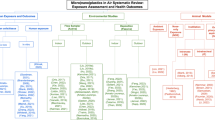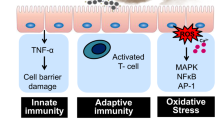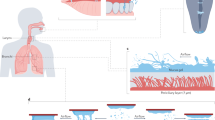Abstract
As workplace air measurements of manufactured nanoparticles are relatively expensive to conduct, models can be helpful for a first tier assessment of exposure. A conceptual model was developed to give a framework for such models. The basis for the model is an analysis of the fate and underlying mechanisms of nanoparticles emitted by a source during transport to a receptor. Four source domains are distinguished; that is, production, handling of bulk product, dispersion of ready-to-use nanoproducts, fracturing and abrasion of end products. These domains represent different generation mechanisms that determine particle emission characteristics; for example, emission rate, particle size distribution, and source location. During transport, homogeneous coagulation, scavenging, and surface deposition will determine the fate of the particles and cause changes in both particle size distributions and number concentrations. The degree of impact of these processes will be determined by a variety of factors including the concentration and size mode of the emitted nanoparticles and background aerosols, source to receptor distance, and ventilation characteristics. The second part of the paper focuses on to what extent the conceptual model could be fit into an existing mechanistic predictive model for ‘‘conventional’’ exposures. The model should be seen as a framework for characterization of exposure to (manufactured) nanoparticles and future exposure modeling.
This is a preview of subscription content, access via your institution
Access options
Subscribe to this journal
Receive 6 print issues and online access
$259.00 per year
only $43.17 per issue
Buy this article
- Purchase on Springer Link
- Instant access to full article PDF
Prices may be subject to local taxes which are calculated during checkout





Similar content being viewed by others
References
Aitchison J., and Brown J.A.C. The Log-Normal Distribution. Cambridge University Press, Cambridge, UK, 1969.
Ayer H.E., and Yeager D.W. Irritants in cigarette smoke plumes. Am J Pub Health 1982: 72: 1283–1285.
Bello D., Wardle B., Yamamoto N., Guzman deVilloria R., Garcia E., Hart A., Ahn K., Ellenbecker M., and Hallock M. Exposure to nanoscale particles and fibers during machining of hybrid advanced composites containing carbon nanotubes. J Nanopart Res 2009: 11: 231–249.
Brouwer D. Exposure to manufactured nanoparticles in different workplaces. Toxicol 2010: 269: 120–127.
Brouwer D.H., van Duuren-Stuurman B, Berges M., Jankowska E., Bard D., and Mark D. From workplace air measurement results towards estimates of exposure?: development of a strategy to assess exposure to manufactured nano-objects. J Nanopart Res 2009: 11: 1867–1881.
Chen F., and Lai A.C.K. An Eulerian model for particle deposition under electrostatic and turbulent conditions. J Aerosol Sci 2004: 35: 47–62.
DeCarlo P., Slowik J., Worsnop D., Davidovits P., and Jimenez J. Particle morphology and density characterization by combined mobility and aerodynamic diameter measurements. Part 1: Theory. Aerosol Sci Technol 2004: 38: 1185–1205.
Demou E., Peter P., and Hellweg S. Exposure to manufactured nanostructured particles in an industrial pilot plant. Ann Occup Hyg 2008: 52: 695–706.
Demou E., Stark W.J., and Hellweg S. Particle emission and exposure during nanoparticle synthesis in research laboratories. Ann Occup Hyg 2009: 53: 829–838.
Fransman W, Cherrie J, van Tongeren M, Schneider T, Tischler M, and Schinkel J, et al. Development of a Mechanistic Model for the Advanced REACH Tool (ART), Beta release. TNO report V 8667, Zeist, The Netherlands, 2009, pp 34–45. available from www.advancedreachtool.com.
Fransman W., Schinkel J., Meijster T., van Hemmen J., Tielemans E., and Goede H. Development and evaluation of an exposure control efficacy Library (ECEL). Ann Occup Hyg 2008: 52 (7): 567–575.
Fujitani Y., Kobayashi T., Arashidani K., Kunugita N., and Suemura K. Measurement of the physical properties of aerosols in a fullerene factory for inhalation exposure assessment. J Occup Environ Hyg 2008: 5: 380–389.
Golanski L., Guiot A., Rouillon F., Pocachard J., and Tardif F. Experimental evaluation of personal protection devices against graphite nanoaerosols: fibre filter media, masks, protective clothing and gloves. Human Experim Toxicol 2009: 28: 353–353.
Gong L., Xu B., and Zhu Y. Ultrafine particles deposition inside passenger vehicles. Aerosol Sci Technol 2009: 43: 544–553.
Hagendorfer H., Lorenz C., and Kaegi R., et al. Size-fractionated characterization and quantification of nanoparticle release rates from a consumer spray product containing engineered nanoparticles. J Nanopart Res 2010: 12: 2481–2494.
He C., Morawska L., and Gilbert D. Particle deposition rates in residential houses. Atmos Environm 2005: 39: 3891–3899.
Health and Safety Executive. Controlling Airborne Contaminants at Work. A guide to local exhaust ventilation (LEV). Health and Safety Executive, UK, 2008 ISBN 9780717662982.
Hinds W.C. Aerosol Technology: Properties, Behavior, and Measurement of Airborne Particles, 2nd ed. Wiley-Interscience, New York, USA, 1999.
International Organization for Standardization. Health and Safety Practices in Occupational Settings Relevant to Nanotechnologies. ISO TR 12885, Geneva, Switzerland, 2008a.
International Organization for Standardization. Nanotechnologies—Terminology and Definitions for Nano-objects—Nanoparticle, Nanofibre and Nanoplate. ISO TS 27687 Geneva, Switzerland, 2008b.
International Standardisation Organiation. Workpklace Atmospheres—Ultrafine, Nanoparticle and Nano-structured Aerosols—Inhalation Exposure Characterization and Assessment. ISO/TR 27628, Geneva, Switzerland, 2007.
Jacobson M.Z., and Seinfeld J.H. Evolution of nanoparticle size and mixing state near the point of emission. Atmos Environ 2004: 38: 1839–1850.
Kim D.S., Hong S.B., Kim Y.J., and Lee K.W. Deposition and coagulation of polydisperse nanoparticles by Brownian motion and turbulence. J Aerosol Sci 2006: 37: 1781–1787.
Koch W Das dynamische verhalten von ultrafeinen aerosolen. In: BIA-Report 7/2003. BIA-Workshop “Ultrafeine Aerosole and Arbeitsplätzen” 2002. Downloaded 2009-07-09 from http://www.dguv.de/bgia/de/pub/rep/rep04/biar0703/index.jsp.
Koponen I.K., Jensen K.A., and Schneider T. Sanding dust from nanoparticle-containing paints: physical characterization. J Phys: Conference Series 2009: 151: 1–9.
Korhonen H., Lehtinen K.E.J., and Kulmala M. Multicomponent aerosol dynamics model UHMA: model development and validation. Atmos Chem Phys 2004: 4: 757–771.
Kousaka Y., Okuyama K., and Endo Y. Re-entrainment of small aggregate particles from a plane surface by air stream. J Chem Engi Japan 1980: 13: 143–147.
Kuhlbusch T.A., and Fissan H. Particle characteristics in the reactor and pelletizing areas of carbon black production. J Occup Environ Hyg 2006: 3: 558–567.
Kuhlbusch T.A.J., Neumann S., and Fissan H. Number size distribution, mass concentration, and particle composition of PM1, PM2.5, and PM10 in bag filling areas of carbon black production. J Occup Environl Hyg 2004: 1: 660–671.
Lai A.C. Particle deposition indoors: a review. Indoor Air 2002: 12: 211–214.
Lai A.C.K., and Chen F. Modeling particle deposition and distribution in a chamber with a two-equation Reynolds-averaged Navier-Stokes model. J Aerosol Sci 2006: 37: 1770–1780.
Luther W Industrial Applications of Nanomaterials—Chances and Risks. Future Technol No. 54, VDI Technologiezentrum GmbH, Düsseldorf, Germany, 2004.
Ma-Hock L., Gamer A.O., Landsiedel R., Leibold E., Frechen T., Sens B., Linsenbuehler M., and van Ravenzwaay B. Generation and characterization of test atmospheres with nanomaterials. Inhal Toxicol 2007: 19: 833–848.
Marquart H., Heussen H., and le Feber M. Stoffenmanger: a web-based control banding tool using an exposure process model. Ann Occup Hyg 2008: 52: 429–441.
Maynard A., and Aitken R. Assessing exposure to airborne nanomaterials; current abilities and future requirements. Nanotoxicol 2007: 1: 26–41.
Maynard A.D., Baron P.A., Foley M., Shvedova A.A., Kisin E.R., and Castranova V. Exposure to carbon nanotube material: aerosol release during the handling of unrefined single-walled carbon nanotube material. J Toxicol Environ Health Part A 2004: 67: 87–107.
McMurry P.H., and Rader D.J. Aerosol wall losses in electrically charged chambers. Aerosol Sci and Technol 1985: 4: 249–268.
Methner M., Hodson L., Dames A., and Geraci C. Nanoparticle emission assessment technique (NEAT) for the identification and measurement of potential inhalation exposure to engineered nanomaterials Part A. J Occup Environ Hyg 2010: 7: 127–132.
Nørgaard A.W., Jensen K.A., Janfeldt C., Lauritsen F.R., Clause P.A., and Wolkoff P. Release of VOCs and particles during use of nanofilm spray products. Environ Sci Technol 2009: 43 (20): 7824–7830.
Occupational Safety & Health Agency. Assigned Protection Factors: Final Rule, Fed Regist 71:50121–50192. 2006: http://www.osha.gov/pls/oshaweb/owadisp.show_document?p_table=FEDERAL_REGISTER&p_id=18846.
Old L., and Methner M. Effectiveness of local exhaust ventilation (LEV) in controlling engineered nanomaterial emissions during reactor cleanout operations. J Occup Environ Hyg 2008: 5: D63–D69.
Park J.P., Kwak B.K., Bae E., Lee J., Kim Y., Choi K., and Yi J. Characterization of exposure to silver nanoparticles in a manufacturing facility. J Nanopart Res 2009: 11: 1705–1712.
Peters T.M., Elzey S., Johnson R., Park H., Grassian V.H., Maher T., and O’Shaughnessy P. Airborne monitoring to distinguish engineered nanomaterials from incidental particles for environmental health and safety. J Occup Environ Hyg 2009: 6: 73–81.
Pui DY.H., Qi C., Stanley N., Oberdörster G., and Maynard A. Recirculating air filtration significantly reduces exposure to airborne nanoparticles. Environ Health Perspect 2008: 116: 863–866.
Qian J., and Ferro A.R. Resuspension of dust particles in a chamber and associated environmental factors. Aerosol Sci Technol 2008: 42: 566–578.
Raabe O.G. The dilution of monodisperse suspensions for aerosolization. Am Ind Hyg Assoc J 1968: 29: 439–443.
Schneider T., and Jensen K.A. Combined single-drop and rotating drum dustiness test of fine to nanosize powders using a small drum. Ann Occup Hyg 2008: 52: 23–34.
Schneider T., and Jensen K.A. Relevance of aerosol dynamics and dustiness for personal exposure to manufactured nanoparticles. J Nanopart Res 2009: 11: 1637–1650.
Schulte P., Geraci C., Zumwalde R., Hoover M., and Kuempel E. Occupational risk management of engineered nanoparticles. J Occupl Environ Hyg 2008: 5: 239–249.
Seaton A., Tran L., AItken R., and Donaldson K. Nanoparticles, human health hazard and regulation. J R Soc Interface 2010: 7 (Suppl 1): S119–S129.
Seipenbusch M, Binder A, and Kasper G Temporal evolution of nanoparticle aerosols in workplace exposure. Ann Occup Hyg 2008: 52: 707–716.
Shaffer R.E., and Rengasamy S. Respiratory protection against airborne nanoparticles: a review. J Nanopart Res 2009: 11: 1661–1672.
Tielemans E., Schneider T., Goede H., Tischer M., Warren N., and Kromhout H., et al. Conceptual model for assessment of inhalation exposure: Defining modifying factors. Ann Occup Hyg 2008: 52: 577–586.
Tielemans E., Warren N., Schneider T., Tischer M., Ritchie P., Goede H., Kromhout H., van Hemmen J., and Cherrie J.W. Tools for regulatory assessment of occupational exposure: development and challenges. J Expos Sci Environ Epidemiol 2007: 17: S72–S80.
Tsai C.-J., Pui D.Y.H., and Liu B.Y.H. Elastic flattening and particle adhesion. Aerosol Sci Tech 1991: 15: 239–255.
Tsai S.-J., Ada EIsaacs J.A., and Ellenbecker M.J. Airborne nanoparticle exposures associated with the manual handling of nanoalumina and nanosilver in fume hoods. J Nanopart Res 2008a: 11: 147–161.
Tsai S.-J., Ashter A., Ada E., Mead J.L., Barry C.F., and Ellenbecker M.J. Airborne nanoparticles release associated with the compounding of nanocomposites using Nanoalumina as fillers. Aerosol Air Quality Res 2008b: 8: 160–177.
Tsai S.-J., Hofmann M., Hallock M., Ada E., Kong J., and Ellenbecker M. Characterization and evaluation of nanoparticle release during the synthesis of single-walled and multiwalled carbon nanotubes by chemical vapor deposition. Environ Sci Technol 2009: 43: 6017–6023.
Van Duuren-Stuurman B. Exploration of the Likelihood of Dermal Exposure to Manufactured Nano Materials; Results from the NANOSH Project. OESSC, Edinburgh, (abstract 20–3) 2009.
Vorbau M., Hillemann L., and Stintz M. Method for the characterization of the abrasion induced nanoparticle release into air from surface coatings. J Aerosol Sci 2009: 40: 209–217.
Whitby K.T. Determination of aerosol growth rates in the atmosphere using lumped mode aerosol dynamics. J Aerosol Sci 1981: 12: 173–178.
Yeganeh B., Kull C.M., Hull M.S., and Marr L.C. Characterization of airborne particles during production of carbonaceous nanomaterials. Environ Sci Tech 2008: 42: 4600–4606.
Zaghbani I., Songmene V., and Khettabi R. Fine and ultrafine particle characterization and modeling in high-speed milling of 6061-T6 aluminum alloy. J Mat Engin Perform 2009: 18: 38–48.
Zalk D.M., Paik S.Y., and Swuste P. Evaluating the control banding nanotool: a qualitative risk assessment method for controlling nanoparticle exposures. J Nanopart Res 2009: 11: 1685–1704.
Zebel G. Coagulation of aerosols. In: Davies C.N. (ed). Aerosol Science. Academic Press, London and New York, 1966.
Acknowledgements
The work was partially sponsored by the EU FP7 project NANODEVICE contract NMP4-LA-2009-211464, the Dutch Ministry of Social Affaires and Employment, the Occupational Safety and Health Advisory Boards for the Industry, Teaching and Research, and the Ministry of Science, Technology and Innovation in Denmark.
Author information
Authors and Affiliations
Corresponding author
Ethics declarations
Competing interests
The authors declare no conflict of interest.
Rights and permissions
About this article
Cite this article
Schneider, T., Brouwer, D., Koponen, I. et al. Conceptual model for assessment of inhalation exposure to manufactured nanoparticles. J Expo Sci Environ Epidemiol 21, 450–463 (2011). https://doi.org/10.1038/jes.2011.4
Received:
Accepted:
Published:
Issue Date:
DOI: https://doi.org/10.1038/jes.2011.4
Keywords
This article is cited by
-
Is using nanosilver mattresses/pillows safe? A review of potential health implications of silver nanoparticles on human health
Environmental Geochemistry and Health (2019)
-
A nanomaterial release model for waste shredding using a Bayesian belief network
Journal of Nanoparticle Research (2018)
-
Engineered nanomaterials: toward effective safety management in research laboratories
Journal of Nanobiotechnology (2016)
-
Can control banding be useful for the safe handling of nanomaterials? A systematic review
Journal of Nanoparticle Research (2016)
-
Life-cycle assessment framework for indoor emissions of synthetic nanoparticles
Journal of Nanoparticle Research (2015)



